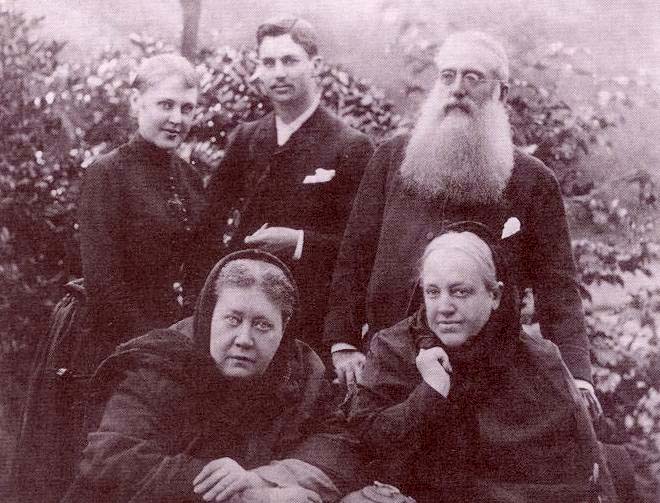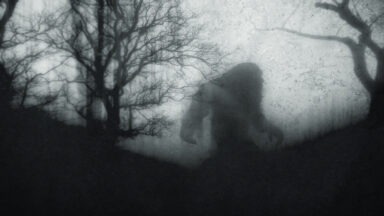Gandhi Learned Hinduism From Blavatsky’s Occult Theosophy

History textbooks will tell you that Mohandas Karamchand Gandhi, a.k.a. Mahatma Gandhi, is one of the most revered names in Indian history for his achievements in ending British imperialism through non-violent, civil disobedience. What they won’t tell you is that there is a strong occult connection to his life of social justice, due to the efforts of Madame Helena Blavatsky and Annie Besant of the Theosophical Society.
What is Theosophy?
Theosophy is a collection of mystical and occult philosophies, largely based on ancient Eastern religion and spirituality. Founded by Helena Blavatsky and Henry Steel Olcott, Theosophy is based around the premise that no religion is higher than truth. Though it takes into account aspects of religion considered to be virtuous, it ascribes to none in particular. This sentiment would later be echoed by Gandhi in a famous quote when he said, “there is no God higher than truth.”
When Madame Blavatsky, a Russian author and occultist started the Theosophical Society, she lived in an apartment in New York City with co-founder Henry Steel Olcott. She had migrated to the U.S. after traveling throughout Tibet where she met “Masters of the Ancient Wisdoms,” later to be referred to as “mahatmas,” who supposedly helped her develop psychic abilities, including telepathy, clairvoyance, and astral projection. She claimed to remain telepathically in contact with these masters throughout her life.
One night Olcott was dozing off, when suddenly he had a vision of an ethereal figure wearing a turban. The figure spoke encouraging words to him and told him to travel to India. It said that the country was the cradle of the oldest civilization and Hindusim was being chipped away by Western colonialism. It urged him to initiate a rebirth of traditional Eastern religions, including Buddhism and Hinduism.
Blavatsky and Olcott took heed of this vision and moved to India, where they were welcomed for their embrace of Hinduism and aversion to the British elite. The Indians weren’t used to Westerners encouraging the practice of their native religion, and expeccted them instead to try to convert them to Christianity, like the Western missionaries in India at the time.
Blavatsky and Olcott soon started a publication expounding on their Theosophical ideologies, much to the chagrin of the British. However, their acceptance by the Indian population led to the creation of a flourishing Theosophical Society and the eventual construction of its headquarters in Adyar. From then on, Theosophy gained significant traction, and the seeds of the Indian Independence Movement were sown.
Gandhi and the Theosophical Society
Blavatsky health eventually started to fail, forcing her to move to London. There she founded the Blavatsky Lodge and was visited by Mohandas K. Gandhi, who was receiving a Western education and studying to become a lawyer.
He was encouraged by Blavatsky and the Theosophists to read Hinduism’s religious text, the Bhagavad Gita, though he initially declined, embarrassed by a lack of knowledge of his native religion. He was also ashamed at his lack of comprehension of Sanskrit, but eventually said he was willing to read along with them.
This opened Gandhi’s perception of the religion, having previously cast it off as antiquated and a superstition that his parents shamefully still practiced. But reading the Gita changed his worldview, and it became his guide to life.

blavatskyarchives.com
This was the first step in breaking down the “civilized” constructs that British imperialist culture had instilled in Gandhi, eventually leading to his non-violent, peaceful protests against that very system. He heard Blavatsky talking about a universal brotherhood and the commonality between all religion and races, inspiring one of the most famous political activists of all time.
It’s well documented that Gandhi attributed much of his inspiration to his time spent with the Theosophical society. He spoke of Blavatsky as being a major catalyst for his ideas, and while he was living in South Africa, Gandhi kept a picture of Annie Besant, Blavatsky’s successor, on his office wall.
Though he was intrigued by the Theosophical Society and its philosophies, he didn’t want to become a member, due to its esoteric, secretive nature. Gandhi believed that secret societies were anathema to democracy and would hinder its success. Besides, Gandhi was a man of the people, though he would eventually join as an associate member, a now defunct title.
Gandhi and Annie Besant
Annie Besant was an Irish activist who was involved in political and spiritual movements, which presented alternatives to capitalism and imperialism. She fought for women’s rights, freedom of thought, and secularism.
Besant was a compelling orator, and a speech she gave at Trafalgur Square in London was partially responsible for the Bloody Sunday of 1887, during which police clashed with protesters of the Irish National League and the Socialist Democratic Federation, arresting hundreds and injuring 75.
Eventually she joined the Theosophical Society after writing a review on one of Blavatsky’s books and subsequently interviewing her. She found socialism and economics lacked a spiritual aspect, and found Theosophy filled that void.
With her history in politics and newfound appreciation for Theosophy, she became involved in Indian politics, launching the foundation of the Indian Home Rule Movement in 1916. She became a member of the Indian National Congress and fronted the first political party in India whose goal was to overthrow the imperial British regime.
Obviously, she was met with some resistance and spent time in jail for a few months, but was eventually released and made president of the Indian National Congress for one year. The man who petitioned for her release from prison and who became her successor was none other than Mohandas Gandhi, when he returned home from his time spent in South Africa.go

From then on, Gandhi would take over for Besant and develop his satyagraha movement to peacefully protest against British imperialism. And though they grew apart due to ideological differences, Besant continued to campaign for Indian independence.
Though the extent to which the occult Theosophical movement influenced Gandhi and Indian independence is not commonly known, it is well documented. It could also be said that the widespread influence of Eastern spirituality on Western culture that is so prominent today can be attributed largely to Blavatsky and Theosophy. Had she and her followers not taken the steps to influence Indian independence and the revivification of Hinduism, Indian history may have been different.
5 Famous Theosophists Other Than Gandhi
- James Joyce – Renowned author of Ulysses and Finnegan’s Wake, Joyce explored Theosophical ideologies and philosophy, along with fellow Irish author of the era, W.B. Yeats.
- Rupert Sheldrake – Rupert Sheldrake, PhD, is a biologist and author best known for his hypothesis of morphic resonance. At Cambridge University, he worked in developmental biology as a Fellow of Clare College.
- Nicholas Roerich – https://www.gaia.com/lp/content/chintamani/ known for interest in hypnosis and spirituality. Led an expedition to Asia to find the mystical Tibetan city of Shambhala. Also spent time with Gandhi and Nehru.
- Henry Wallace – Vice President of the United States under FDR. Was criticized for his connection with the occult and relationship with Nicholas Roerich.
- Manly P. Hall – Canadian author and mystic famous for his work The Secret Teachings of All Ages: An Encyclopedia Outline of Masonic, Hermetic, Qabbalistic and Rosicrucian Symbolical Philosophy
Gematria: Understanding the Numerical System that Decodes the Divine

Have you ever thought that numbers might tell stories just like words do? Gematria, a fascinating form of numerology found in Kabbalistic teachings, suggests that there’s a deep connection between numbers and words.
This ancient method, deeply rooted in sacred texts, proposes that every letter and word carries a numerical value that unveils deeper meanings. These connections might even offer clues to understanding both historical and future events through sacred texts like the Torah.
The concept of gematria numerology stems from the idea that mathematics is the universal language of nature and within it may be the keys to explaining our universe or evidence of supernatural power. Marty Leeds has taken this concept of the Kabbalistic gematria and applied it to the English language, believing that he has found a cipher in our alphabet to prove this theory.
What is Gematria?
Gematria is a numerological system where each letter of the Hebrew alphabet is assigned a specific numerical value. This system is used to interpret the hidden meanings within words, names, or phrases, based on the belief that God created the universe through the numerical values of Hebrew letters.
This practice, deeply rooted in the mystical aspects of the Hebrew Bible and embraced within Kabbalistic traditions, transcends simple word-to-number correspondences. It serves as a profound tool to explore the divine blueprint encoded within sacred texts, suggesting that every letter and word carries an intrinsic numerical value that reveals deeper, spiritual insights.
Modern scholars, including Marty Leeds, have extended the principles of gematria beyond Hebrew to the English language, proposing that these numerical ciphers uncover universal truths and mystical insights across different languages and cultures.
How Does Gematria Work?
The idea behind gematria numerology is that mathematics is a universal language, which might hold the keys to explaining our universe or even pointing to the existence of supernatural powers. In the practice of gematria, each Hebrew letter’s numerical value allows scholars and mystics to draw connections between words and uncover deeper meanings. These numerical values can also reflect broader concepts and beliefs. For instance:
- Number 888: In Christian numerology, the number 888 represents Jesus, or more specifically Christ the Redeemer. This comes from the fact that in Greek gematria, the letters of Jesus’ name add up to 888. This number is seen as a representation of infinite love and redemption.
- Number 666: Often recognized as the number of the beast from the Book of Revelation in the New Testament, 666 is associated with evil and Satan in popular culture. However, in the context of gematria, this number can have more complex interpretations depending on the scriptural and cultural context.
- Number 4: The number 4 is often seen as a symbol of stability and order in many cultures. In the context of gematria, it can represent the four elements (earth, water, air, fire), the four cardinal directions, or the foundational aspects of creation. This reflects its universal significance in forming the basis of the world’s structure.
- Number 33: This is a number with significant importance in Freemasonry where it signifies the highest degree of the Scottish Rite. In Kabbalistic tradition, it can represent the age at which Jesus was crucified and, by extension, a period of accomplishment or completion.
For example, the tzitzit, a shawl worn during Jewish ceremonies, provides a perfect illustration: the numerical value of its knots and strands adds up to 613, which intriguingly corresponds to the total number of commandments in the Torah. These numerical associations are believed to hold deeper spiritual or mystical significance, revealing connections that go beyond the surface and delve into the divine or universal truths.
What is Gematria Used For?
Gematria is not just about playing with numbers; it’s a tool embedded in the Kabbalistic tradition to interpret deeper meanings within sacred texts. Scholars use it to uncover insights about life, the divine, and cosmic mysteries. Beyond Judaism, gematria also appears in other cultures and languages, demonstrating its widespread influence and importance in various religious and philosophical traditions.
Exploring the Origins of Gematria
The practice of gematria is believed to have originated in the Jewish mystical tradition known as Kabbalah, but its influences can be traced back even further to ancient Greek and Arabic cultures. The practice was likely influenced by Greek isopsephy and Arabic abjad numerals, which also connect letters with numerical values. These practices highlight a universal quest to find deeper meaning in language and numbers across different cultures and historical periods.
Gematria in Different Cultures
While Hebrew gematria is most prominent, similar numerological practices exist in other cultures such as Greek and Arabic. These systems adapt to the peculiarities of their own languages and scriptures, providing a broad field of study for numerologists worldwide. The Greek system, for example, has been referenced by philosophers like Plato, showing gematria’s influence on early philosophical thought.
Examples of Gematria in Practice
- Biblical Texts and Jewish Tradition: Gematria is often used to interpret the Hebrew Bible. For instance, the Hebrew word for ‘life’ (חי) sums to 18, making it a significant number in Jewish culture.
- Modern Applications by Marty Leeds: Leeds argues that even the English alphabet can be broken down into numbers that reveal hidden codes, blending traditional and contemporary interpretations of gematria.
Kabbalistic Connections
In Kabbalah, gematria is not merely a numerological curiosity; it is an essential tool for exploring the esoteric and mystical dimensions of Hebrew scriptures. This practice is particularly valuable for interpreting the hidden meanings behind the names of God, such as the Tetragrammaton (YHWH) and other sacred words.
Kabbalists believe that each letter in these divine names carries specific numerical values that are direct expressions of cosmic energy and divine attributes. By decoding these numbers, mystics can gain insights into the fundamental structures of existence and the inner workings of the cosmos.
The use of gematria in Kabbalistic studies is seen as a method of interpretation and a form of meditation and spiritual practice, aimed at bringing practitioners closer to divine wisdom.
Key Aspects of Kabbalistic Gematria:
- Interpretation of divine names and cosmic energy
- Insights into the fundamental structures of existence
- Meditation and spiritual practice to connect with divine wisdom
Practical Uses of Gematria Today
While its roots are ancient, gematria has evolved to meet the needs of modern society. Today, it finds applications in various personal and practical contexts:
- Event Planning: Individuals use gematria to select auspicious dates for significant events, such as weddings or business openings. Aligning activities with favorable numerical values is believed to influence outcomes positively.
- Personal Insight: Gematria is used to analyze personal names, birth dates, and keywords, helping individuals uncover deeper spiritual meanings and potential life paths.
- Creative Applications: Artists and writers often use gematria to structure their works around specific numerical themes, adding a layer of symbolic significance to their creative outputs.
- Digital Accessibility: In the digital age, the principles of gematria have been adapted for online use, making this ancient wisdom accessible globally and allowing its exploration across different languages and cultures.
The Ongoing Relevance of Gematria
Gematria’s roots stretch deep into Kabbalistic mysticism and have branched out into modern linguistic studies. It remains a vital tool in the study of sacred texts and offers a unique perspective on the numerical patterns that many believe govern the universe. Whether used for spiritual discovery, theological study, or philosophical exploration, gematria captivates those who seek to understand the intersection of numbers and words in various cultures.
Gematria FAQs
How do you calculate words using gematria?
Calculating a word’s gematria value involves adding up the numerical values of each letter in the word. Different traditions may have their own set of values and methods, adding a layer of complexity to the calculations.
What is a Gematria Calculator?
A Gematria calculator is a digital tool that simplifies these calculations, allowing users to quickly find the numerical value of words and phrases across different Gematria systems.
How does gematria work in the Hebrew language?
In Hebrew, each letter is assigned a numerical value, and these numbers are used to explore relationships and uncover deeper symbolic meanings between words, based on their numerical equivalence.




































